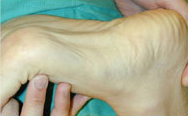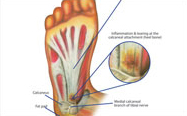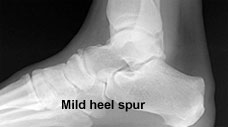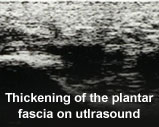Plantar Fasciitis
 The plantar fascia is a celery-like structure that connects the heel to the ball of the foot. It is much like a band that connects a tripod, the tripod being the heel and the bones of the ball of the foot. The goal of the plantar fascia is to stabilize and support the arch, assist with pressure distribution across the foot and to transfer the strength of the Achilles tendon to the forefoot by helping propulse the foot from heel to toe motion.
The plantar fascia is a celery-like structure that connects the heel to the ball of the foot. It is much like a band that connects a tripod, the tripod being the heel and the bones of the ball of the foot. The goal of the plantar fascia is to stabilize and support the arch, assist with pressure distribution across the foot and to transfer the strength of the Achilles tendon to the forefoot by helping propulse the foot from heel to toe motion.
The plantar fascia will become strained with excess force mainly in the heel attachment site but also sometimes in the central arch portion. This strain is mainly due to excess pull or force on the plantar fascia resulting in microscopic small tears and swelling. After a period of rest the fascia will get stretched with initial standing which results in excess strain on the structure and continued small tears and swelling. Over the course of weeks and months there is scar tissue formation resulting in chronic pain.
Plantar Fasciitis & Plantar Fasciosis (Chronic Plantar Fasciitis)
 Plantar Fasciitis & Plantar Fasciosis (Chronic Plantar Fasciitis)
Plantar fascitis is divided into acute and chronic divisions. It is well documented that soft tissue trauma has two points, an acute and chronic level. To that end, plantar fascitis in the acute stage is considered to be the period during the first three to maximum six months. During this first three to six months there is usually swelling of the fascia and most of the treatments used are anti-inflammatory type care. Subsequent to the initial swelling period there is a non-inflammatory scar tissue formation period during which the body no longer will respond to the region and considers the region to be "a normal" finding. This chronic plantar fascia period is usually after the initial three to six month inflammatory period and is the body's response to chronic injury. The body shuts down blood to the region which is necessary for healing and therefore there is little to no response to anti-inflammatory treatments. The common name for this chronic phase of heel pain is plantar fasciosis.
Plantar Fasciitis & Plantar Fasciosis (Chronic Plantar Fasciitis)
Plantar fascitis is divided into acute and chronic divisions. It is well documented that soft tissue trauma has two points, an acute and chronic level. To that end, plantar fascitis in the acute stage is considered to be the period during the first three to maximum six months. During this first three to six months there is usually swelling of the fascia and most of the treatments used are anti-inflammatory type care. Subsequent to the initial swelling period there is a non-inflammatory scar tissue formation period during which the body no longer will respond to the region and considers the region to be "a normal" finding. This chronic plantar fascia period is usually after the initial three to six month inflammatory period and is the body's response to chronic injury. The body shuts down blood to the region which is necessary for healing and therefore there is little to no response to anti-inflammatory treatments. The common name for this chronic phase of heel pain is plantar fasciosis.
During the initial phase, relief of inflammation and support are the most common treatments. Rest and decrease in inflammation allow the fascia to heal and added support decreases chronic strain on the fascia. In the chronic phase known as plantar fasciosis the treatment is inflammatory or healing in nature in order to increase blood to the damaged tissue and re-start the body's healing response to return to the damaged tissue and heal the region. Addition of support in the shape of an orthotic or boot is used to decrease strain on the fascia and allow the body to respond and heal the damaged region.
Treatments in the initial 3-6 month plantar fascia phase include:
- Arch support or orthotic
- Physical therapy
- Cortisone injection (rarely first step)
- Non steroidal anti-inflammation medication



